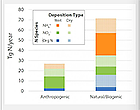The world’s oceans are less affected by human activities then previously suggested by atmospheric models when it comes to increased
nitrogen levels, according to a new study published in Proceedings of the National Academy of Sciences. The majority of nitrogen found in the oceans comes from the oceans themselves instead of human pollution blown off shore, which contradicts most models, the researchers say. That’s both good news and bad news. On the plus side, “People may not be polluting the ocean as much as we thought,” says Meredith Hastings, associate professor at Brown University, one of the study’s co-authors. Excess nitrogen can throw aquatic ecosystems out of balance and lead to large algal blooms that can be deadly for sea creatures. However, nitrogen also stimulates the growth of phytoplankton, which increases the oceans’ ability to absorb carbon dioxide from the atmosphere, thus mitigating carbon emissions to some extent.
Study suggests most nitrogen found in oceans comes from natural sources
More From E360
-
Biodiversity
Shrinking Cod: How Humans Are Impacting the Evolution of Species
-
Cities
‘Sponge City’: How Copenhagen Is Adapting to a Wetter Future
-
INTERVIEW
On Controlling Fire, New Lessons from a Deep Indigenous Past
-
Solutions
Paying the People: Liberia’s Novel Plan to Save Its Forests
-
OPINION
Forest Service Plan Threatens the Heart of an Alaskan Wilderness
-
INTERVIEW
Pakistan’s Solar Revolution Is Bringing Power to the People
-
Food & Agriculture
In Uganda, Deadly Landslides Force an Agricultural Reckoning
-
Energy
Why U.S. Geothermal May Advance, Despite Political Headwinds
-
Food & Agriculture
In War Zones, a Race to Save Key Seeds Needed to Feed the World
-
Climate
Lightning Strikes the Arctic: What Will It Mean for the Far North?
-
RIVERS
A Win for Farmers and Tribes Brings New Hope to the Klamath
-
Solutions
Deconstructing Buildings: The Quest for New Life for Old Wood
